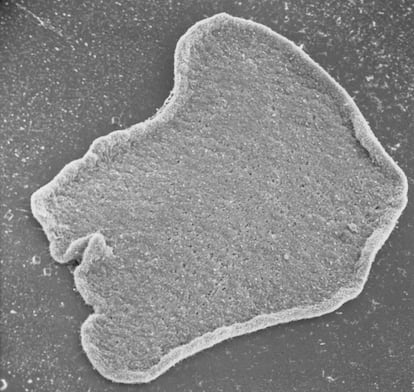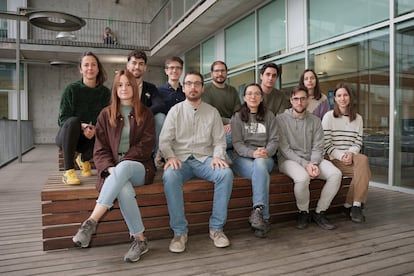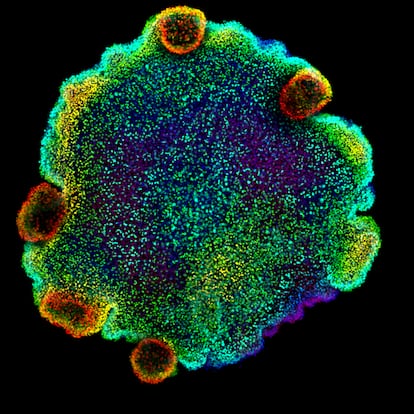A strange pancake-shaped creature shows the origin of thought
Placozoans separated from human beings 800 million years ago. They barely measure a millimeter, but their cells contain neuropeptides, which can transmit messages like neurons

Most religions across the world have a similar origin story, in which an almighty god creates mankind, out of nothing, with a fully functioning brain. But placozoans — a blob-like animal less than a millimeter in size that floats in seawater — suggest otherwise. They may go unnoticed, but they are extraordinary creatures. Under the microscope, they look like tiny pancakes. They don’t have any organs, much less a brain. However, these strange animals are able to coordinate as a group to attack their prey. On Tuesday, a team of researchers, led by Spanish biologist Arnau Sebé Pedrós, revealed that the cells of these unusual beings contain the first hints of the origin of neurons, which transmit human thought.
Placozoans may have just 50,000 cells, but they have surprising abilities. They are immortal, because they can multiply asexually indefinitely. A piece of placozoan can form another placozoan. They can also be reconfigured into shapes other than a pancake, such as a donut or a whip. A person is made up of 30 trillion cells, with many well-differentiated types, such as brain neurons or red blood cells. Placozoans, on the other hand, are made up of two simple layers of similar cells, stuck together like two slices of cheese. Its simplicity can shed light on how single-cell organisms came together to form increasingly sophisticated multicellular beings.
The researchers care for thousands of placozoans in their laboratory in the Center for Genomic Regulation, in Barcelona. According to their calculations, multicellular animals emerged about 850 million years ago. Soon afterward, around 800 million years ago, the paths of the families that gave rise to placozoans and humans diverged. “People have a tendency to see living fossils in nature. We don’t know if our common ancestor looked like a placozoan, but some aspects of its biology were already there,” says Sebé Pedrós, a 37-year-old biologist from the Spanish town of Lleida.
His team studied the four known species of placozoans cell by cell, including the first placozoan ever discovered, which was found in 1883 by the German zoologist Franz Eilhard Schulze in a seawater aquarium in Graz, Austria. Schulze baptized that mysterious creature Trichoplax adhaerens, from the Greek words thrix (hair) and plax (plate) and the Latin word adhaerens (adhering), which was given this name due to its tendency to stick to its substrate. In other words, its name could be roughly translated as “adhering hairy plate.” Placozoans are the simplest animals on the planet, barring Myxozoa, parasites with few cells that cannot live on their own.
In their research, Sebé Pedrós and his colleagues observed that placozoans are capable of coordinating their 50,000 cells thanks to the fact that some of them can send messages using molecules called neuropeptides, like the neurons in the human brain. “We have found a rudiment of certain aspects of our nervous system,” says the biologist. These secretory cells still lack the processes that transmit nerve impulses (axons) and the processes that receive them (dendrites) in human neurons.

The new results, published on Tuesday in the journal Cell, support the chemical brain hypothesis, postulated by Hungarian biologist Gáspár Jékely, from the University of Heidelberg in Germany. “This study reveals deep molecular similarities between the neurons of placozoans and the neurons of bilateral animals [symmetrical ones, such as humans],” says Jékely. “These similarities, together with the fact that placozoan neurons only communicate through chemical signals, support the idea that nervous systems may have first evolved as a collection of diverse, chemically connected cells, before developing specialized processes [such as axons and dendrites] and synapses,” adds the biologist, who did not participate in the study.
Sebé Pedrós expounds on this idea. “Probably, to coordinate the cells of a small organism, with only two layers, it was enough to have cells secreting chemical signals. However, the moment you get big and start to gain three-dimensionality, you also need to emit electrical signals and have cell-to-cell communication interfaces, which are synapses,” explains the Spanish biologist. The neurons of a tall person, with extensions that allow a stimulus to be immediately felt in the foot, can measure more than two meters.
Sebé Pedrós’ research team believes that the first modern neuron did not appear until about 650 million years ago, in the common ancestor of cnidarians (a group that includes hydra and jellyfish) and human beings. The great mystery is what happened then to ctenophores, another branch of animals that set out on its own path 850 million years ago. These organisms are similar to jellyfish and also have neurons, but they are different. “It is still too early to say that ctenophores invented neurons independently, but I think there is more and more evidence that this could be the case,” explains Sebé Pedrós.

Sign up for our weekly newsletter to get more English-language news coverage from EL PAÍS USA Edition
Tu suscripción se está usando en otro dispositivo
¿Quieres añadir otro usuario a tu suscripción?
Si continúas leyendo en este dispositivo, no se podrá leer en el otro.
FlechaTu suscripción se está usando en otro dispositivo y solo puedes acceder a EL PAÍS desde un dispositivo a la vez.
Si quieres compartir tu cuenta, cambia tu suscripción a la modalidad Premium, así podrás añadir otro usuario. Cada uno accederá con su propia cuenta de email, lo que os permitirá personalizar vuestra experiencia en EL PAÍS.
¿Tienes una suscripción de empresa? Accede aquí para contratar más cuentas.
En el caso de no saber quién está usando tu cuenta, te recomendamos cambiar tu contraseña aquí.
Si decides continuar compartiendo tu cuenta, este mensaje se mostrará en tu dispositivo y en el de la otra persona que está usando tu cuenta de forma indefinida, afectando a tu experiencia de lectura. Puedes consultar aquí los términos y condiciones de la suscripción digital.
More information
Últimas noticias
From safe-haven investment to geostrategic weapon: Who owns the most gold and where are the bars kept?
Todd Green, head of the company that created ‘Candy Crush’: ‘Success for us is that players want to play for years’
Prices soar and Venezuela’s economy struggles under Trump’s pressure: ‘People are living day to day’
The brief rise and retreat of Generation Z in Mexico
Most viewed
- Why we lost the habit of sleeping in two segments and how that changed our sense of time
- Charles Dubouloz, mountaineering star, retires at 36 with a farewell tour inspired by Walter Bonatti
- Venezuela faces its most tense Christmas yet
- CBS in crisis after pulling a report on Trump’s deportations to El Salvador (which later leaked online)
- Trump’s obsession with putting his name on everything is unprecedented in the United States










































